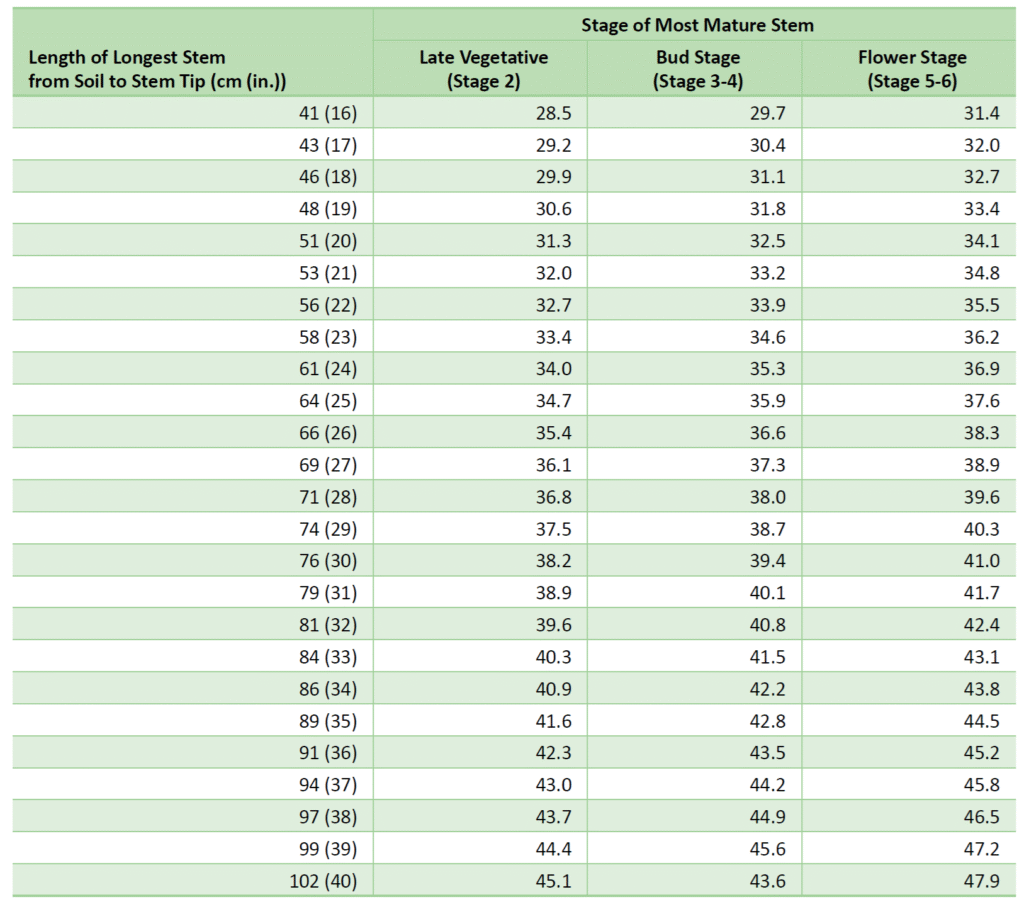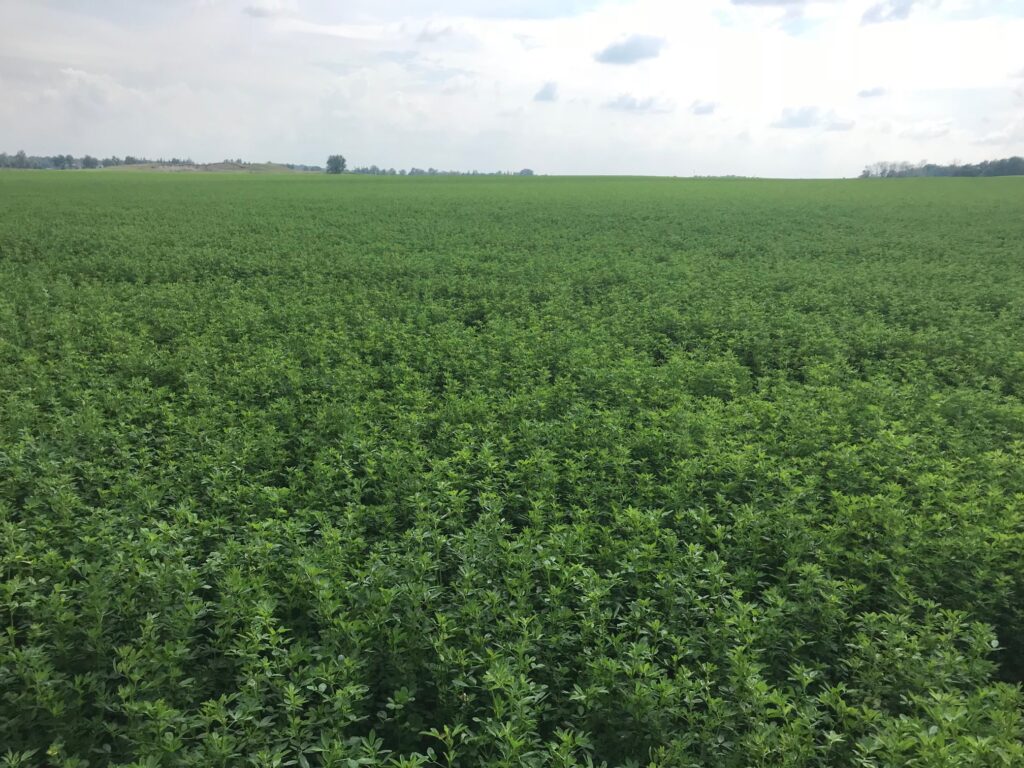Stage of maturity at harvest is the most important factor in determining the nutritional quality of a forage crop. Grasses lose nutritional quality faster than legumes. Mixed stands should be harvested when the grass is ready. If the alfalfa is maturing later than the grass, waiting on the alfalfa to reach the ideal growth stage will result in higher yields of a lower-quality forage.
In addition, dry weather is required to make dry hay. A compromise may have to be made between rained-on hay at the ideal time of cutting, or hay that is a little more mature that has not been rained on. Silage and baleage do not require as much wilting, so the window of dry weather required to dry down the crop is generally shorter. This usually reduces how often producers must choose between optimum maturity or a cut crop that has not been rained on.
There are a few methods that can be used to estimate the ideal maturity to harvest alfalfa.
Growing Degree Days
Growing degree days (GDD), an estimate of accumulated heat, are used to predict the growth and development of plants, insects and diseases during the growing season. Development of these organisms are very dependent on temperature and the daily accumulation of heat. The amount of heat required to advance a plant or pest to the next development stage remains constant from year to year, however, the actual amount of time (days) can vary considerably because of weather conditions.
Each crop, insect and disease species has a minimum base temperature or threshold below which development does not occur. For alfalfa, this is 5˚C (note that American sources work in Fahrenheit using base 41˚F). To calculate GDD, first determine the mean temperature for the day. This is usually done by taking the maximum and minimum temperatures for the day, adding them together and dividing by 2. The base temperature is then subtracted from the mean temperature to give a daily GDD. If the daily GDD calculates to a negative number, it is recorded as 0. Each daily GDD is then added up (accumulated) over the growing season.


Tracking GDDs can help producers consistently harvest at their ideal forage stage. For example, it takes about 390 GDDs (Base 5˚C, March 1 start) for alfalfa to reach the early flower stage.
Scissors-cut Sampling and Analysis
Plant samples are taken once or twice a week (Monday to Thursday) in the morning at a normal cutting height. Multiple samples are “grabbed” at random from various places in a field to get a representative sample. Avoid field edges and smaller damaged areas. Samples should be about 225 g (0.5 lb). Remove excess moisture from the sample with a towel and place in a paper bag. Deliver to the lab with overnight express delivery. Samples should not be taken on Friday or over the weekend to prevent them spoiling before they get to the lab. Labs typically use near infrared reflectance spectroscopy (NIRS) and they should be calibrated to accurately do this with fresh samples.
Results should be available from the lab by e-mail the following day. Courier and lab costs are low relative to feed bills.
Predictive Equations of Alfalfa Quality (PEAQ)
The PEAQ method was developed at the University of Wisconsin. It uses the longest stem and the most mature stem to estimate the neutral detergent fibre (NDF) of the alfalfa in a standing crop.
Technique:
1. Walk through the field and choose a representative 0.2-square-metre (2 square-foot) area. Determine the growth stage of the most mature stem in the sampling area. The most mature stem will be in either vegetative (no visible buds), bud (buds visible on at least one node) or flower stage (at least one open flower on the stem).
2. Measure the length of the longest stem in the 0.2-square-metre (2-square-foot) area. Measure it from the soil surface (next to the plant crown) to the tip of the stem (not to the tip of the highest leaf blade). Straighten the stem for an accurate measure of its length. The longest stem may not be the most mature stem. Make sure to measure the longest stem, not an average length stem.
3. Based on the growth stage of the most mature stem and length of the longest stem, use the accompanying chart (Table 1) to determine estimated NDF of the standing alfalfa forage.
4. Repeat these steps in four or five representative areas across the field. Sample more times for fields larger than 12 ha (30 acres). Average all estimates for a field average.
For example, if the most mature stem is in bud stage, and the longest stem is 71 cm (28 in.), the NDF is estimated to be 38%.

PEAQ estimates the quality of the standing crop and does not account for changes in quality due to wilting (respiration), harvesting (leaf loss) and storage (fermentation). These factors may increase the final NDF content from 2% (haylage) up to 6% (hay), assuming good wilting and harvesting conditions. This procedure is most accurate for good stands of pure alfalfa with normal growth.
The NDF of the grasses in mixed stands will be higher than the alfalfa, so stands with significant grass must be cut earlier.
Similar charts are also available for acid detergent fibre (ADF) and relative feed value (RFV). A PEAQ stick has been developed that incorporates the NDF estimates onto an easy-to-read measuring stick, which can be used in the field.
PEAQ is intended to be used as a tool in making cutting decisions and is not to replace forage analysis and ration balancing. Studies have shown that NDF can be estimated using PEAQ with reasonable accuracy compared to GDD or scissors cutting. PEAQ is not perfect, but it is likely more accurate than using calendar date or growth stage alone.
PEAQ was designed for pure alfalfa stands. Recently, le Centre de référence en agriculture et agroalimentaire du Québec (CRAAQ) developed Nutri-Fourrager for mixed alfalfa/grass stands. While the tool was only developed in French, the web browser translation makes it usable in English as well.
